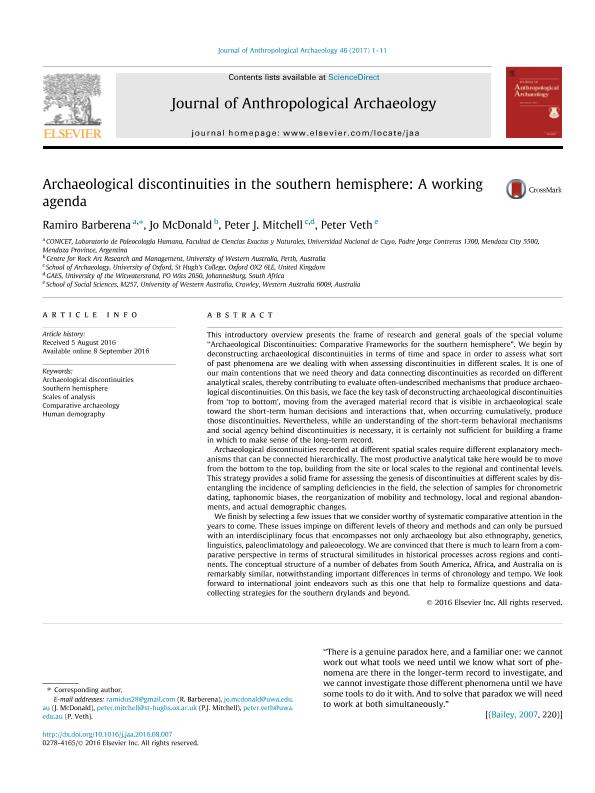Artículo
Archaeological discontinuities in the southern hemisphere: A working agenda
Fecha de publicación:
06/2017
Editorial:
Academic Press Inc.
Revista:
Journal of Anthropological Archaeology
ISSN:
1090-2686
Idioma:
Inglés
Tipo de recurso:
Artículo publicado
Clasificación temática:
Resumen
This introductory overview presents the frame of research and general goals of the special volume “Archaeological Discontinuities: Comparative Frameworks for the southern hemisphere”. We begin by deconstructing archaeological discontinuities in terms of time and space in order to assess what sort of past phenomena are we dealing with when assessing discontinuities in different scales. It is one of our main contentions that we need theory and data connecting discontinuities as recorded on different analytical scales, thereby contributing to evaluate often-undescribed mechanisms that produce archaeological discontinuities. On this basis, we face the key task of deconstructing archaeological discontinuities from ‘top to bottom’, moving from the averaged material record that is visible in archaeological scale toward the short-term human decisions and interactions that, when occurring cumulatively, produce those discontinuities. Nevertheless, while an understanding of the short-term behavioral mechanisms and social agency behind discontinuities is necessary, it is certainly not sufficient for building a frame in which to make sense of the long-term record. Archaeological discontinuities recorded at different spatial scales require different explanatory mechanisms that can be connected hierarchically. The most productive analytical take here would be to move from the bottom to the top, building from the site or local scales to the regional and continental levels. This strategy provides a solid frame for assessing the genesis of discontinuities at different scales by disentangling the incidence of sampling deficiencies in the field, the selection of samples for chronometric dating, taphonomic biases, the reorganization of mobility and technology, local and regional abandonments, and actual demographic changes. We finish by selecting a few issues that we consider worthy of systematic comparative attention in the years to come. These issues impinge on different levels of theory and methods and can only be pursued with an interdisciplinary focus that encompasses not only archaeology but also ethnography, genetics, linguistics, paleoclimatology and paleoecology. We are convinced that there is much to learn from a comparative perspective in terms of structural similitudes in historical processes across regions and continents. The conceptual structure of a number of debates from South America, Africa, and Australia on is remarkably similar, notwithstanding important differences in terms of chronology and tempo. We look forward to international joint endeavors such as this one that help to formalize questions and data-collecting strategies for the southern drylands and beyond.
Archivos asociados
Licencia
Identificadores
Colecciones
Articulos(CCT - MENDOZA)
Articulos de CTRO.CIENTIFICO TECNOL.CONICET - MENDOZA
Articulos de CTRO.CIENTIFICO TECNOL.CONICET - MENDOZA
Citación
Barberena, Ramiro; McDonald, Jo; Mitchell, Peter J.; Veth, Peter; Archaeological discontinuities in the southern hemisphere: A working agenda; Academic Press Inc.; Journal of Anthropological Archaeology; 46; 6-2017; 1-11
Compartir
Altmétricas




